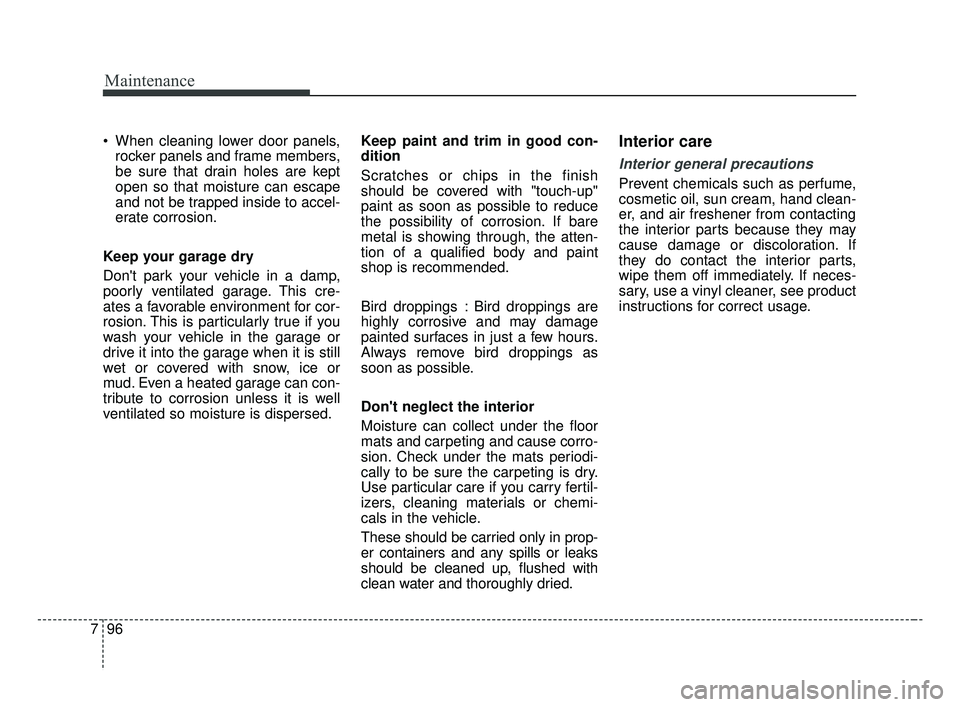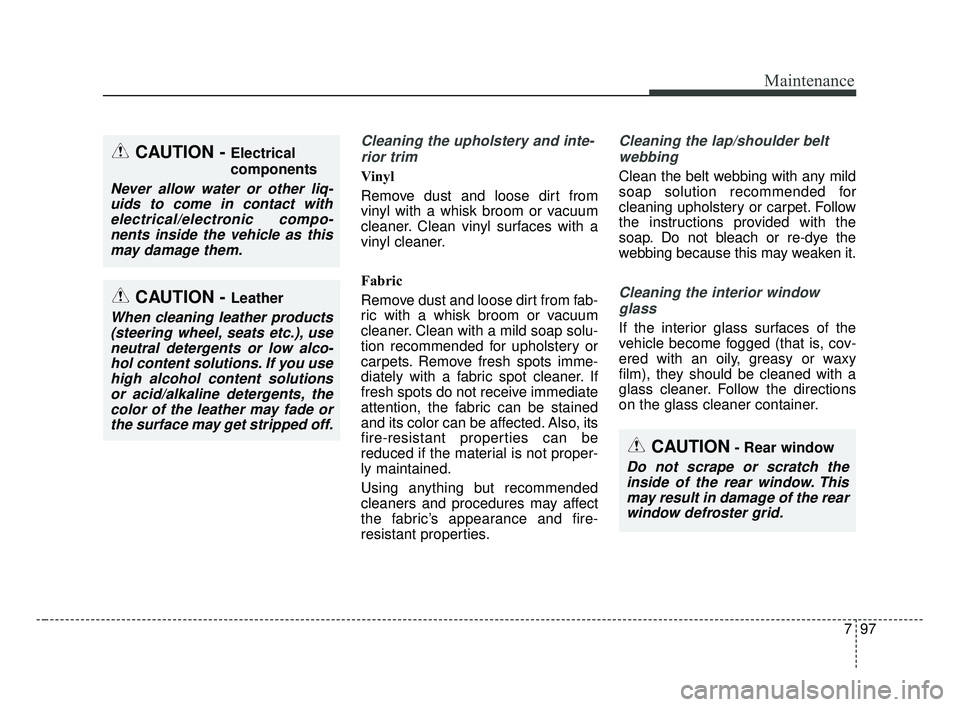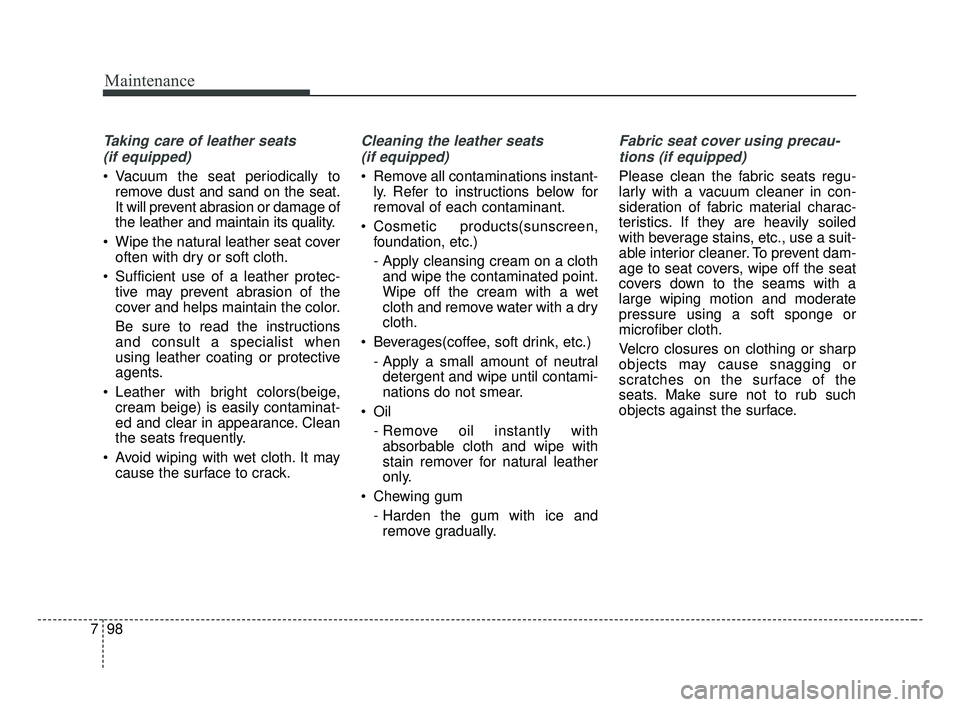2019 KIA FORTE oil
[x] Cancel search: oilPage 490 of 550
![KIA FORTE 2019 Owners Manual 767
Maintenance
Fuse Name Fuse ratingCircuit Protected
FUSE
POWER OUTLET 220AFront Power Outlet
TCU 115A [GAMMA 1.6L T-GDI] TCM (Transmission Control Module)
VACUUM PUMP20A[GAMMA 1.6L T-GDI] Vacuum P KIA FORTE 2019 Owners Manual 767
Maintenance
Fuse Name Fuse ratingCircuit Protected
FUSE
POWER OUTLET 220AFront Power Outlet
TCU 115A [GAMMA 1.6L T-GDI] TCM (Transmission Control Module)
VACUUM PUMP20A[GAMMA 1.6L T-GDI] Vacuum P](/manual-img/2/40396/w960_40396-489.png)
767
Maintenance
Fuse Name Fuse ratingCircuit Protected
FUSE
POWER OUTLET 220AFront Power Outlet
TCU 115A [GAMMA 1.6L T-GDI] TCM (Transmission Control Module)
VACUUM PUMP20A[GAMMA 1.6L T-GDI] Vacuum Pump
FUEL PUMP20AFuel Pump Relay
COOLING FAN 230A[NU 2.0L AKS] Cooling Fan 2 Relay, Cooling Fan 3 Relay
B+140AInstrument Panel Junction Block (Long Term Load Latch Relay, Fuse : (BRAKE SWITCH, IBU
1, AIR BAG 2, DOOR LOCK, SEAT HEATER REAR, MODULE 1))
DCT 140A[GAMMA 1.6L T-GDI] TCM (Transmission Control Module)
DCT 240A[GAMMA 1.6L T-GDI] TCM (Transmission Control Module)
ABS 140AABS (Anti-lock brake system) Module, ESC (Electronic Stability Control) Module, Multipurpose
Check Connector
ABS 230AABS (Anti-lock brake system) Module, ESC (Electronic Stability Control) Module
POWER OUTLET 140APower Outlet Relay
SENSOR 210A
[NU 2.0L AKS] Purge Control Solenoid Valve, Oil Control Valve #1/#2/#3, Canister Close
Valve, Mass Air Folw Sensor, Fuel Filter Warning Sensor, A/Con Relay
[GAMMA 1.6L T-GDI] Purge Control Solenoid Valve, Oil Control Valve #1/#2, Canister Close
Valve, RCV Control Solenoid Valve, E/R Junction Block (Cooling Fan Relay 1)
ECU 210A[GAMMA 1.6L T-GDI] ECM (Engine Control Module)
ECU 120A[NU 2.0L AKS] PCM (Power train Control Module)
[GAMMA 1.6L T-GDI] ECM (Engine Control Module)
INJECTOR15A[NU 2.0L AKS] Injector #1~#4
Engine room compartment fuse panel
BDm CAN (ENG) 7.qxp 7/4/2018 10:26 AM Page 67
Page 491 of 550
![KIA FORTE 2019 Owners Manual Maintenance
68
7
Fuse Name Fuse ratingCircuit Protected
FUSE
SENSOR 115A[NU 2.0L AKS] Oxygen Sensor (Up), Oxygen Sensor (Down)
[GAMMA 1.6L T-GDI] Oxygen Sensor (Up), Oxygen Sensor (Down)
IGN COIL20A[ KIA FORTE 2019 Owners Manual Maintenance
68
7
Fuse Name Fuse ratingCircuit Protected
FUSE
SENSOR 115A[NU 2.0L AKS] Oxygen Sensor (Up), Oxygen Sensor (Down)
[GAMMA 1.6L T-GDI] Oxygen Sensor (Up), Oxygen Sensor (Down)
IGN COIL20A[](/manual-img/2/40396/w960_40396-490.png)
Maintenance
68
7
Fuse Name Fuse ratingCircuit Protected
FUSE
SENSOR 115A[NU 2.0L AKS] Oxygen Sensor (Up), Oxygen Sensor (Down)
[GAMMA 1.6L T-GDI] Oxygen Sensor (Up), Oxygen Sensor (Down)
IGN COIL20A[NU 2.0L AKS] Ignition Coil #1~#4
[GAMMA 1.6L T-GDI] Ignition Coil #1~#4
ECU 315A[NU 2.0L AKS] PCM (Power train Control Module)
[GAMMA 1.6L T-GDI] ECM (Engine Control Module)
A/C10A[NU 2.0L AKS] A/Con Relay
ECU 510A[NU 2.0L AKS] PCM (Power train Control Module)
[GAMMA 1.6L T-GDI] ECM (Engine Control Module)
SENSOR 415A[GAMMA 1.6L T-GDI] Vacuum Pump
ABS 310AABS (Anti-lock brake system) Module, ESC (Electronic Stability Control) Module
TCU 215A[NU 2.0L AKS] Transaxle Range Switch
[GAMMA 1.6L T-GDI] Transaxle Range Switch, TCM
SENSOR 310A[NU 2.0L AKS] Fuel Pump Relay
[GAMMA 1.6L T-GDI] Fuel Pump Relay
ECU 415A[NU 2.0L AKS] PCM (Power train Control Module)
[GAMMA 1.6L T-GDI] ECM (Engine Control Module)
WIPER25A[NU 2.0L AKS] Wiper Relay
[GAMMA 1.6L T-GDI] Wiper Relay
HORN15A[NU 2.0L AKS] Horn Relay
[GAMMA 1.6L T-GDI] Horn Relay
BDm CAN (ENG) 7.qxp 7/4/2018 10:26 AM Page 68
Page 499 of 550

Maintenance
76
7
5. Install a new bulb-socket assem-
bly in the headlamp assembly by
aligning the tabs on the bulb-sock-
et with the slots in the headlamp
assembly. Push the bulb-socket
into the headlamp assembly and
turn the bulb-socket clockwise.
6. Connect the headlamp bulb sock- et-connector.
7. Install the headlamp bulb cover by turning it clockwise.Headlamp bulb
OQL075058
WARNING- Halogen
bulbs
Halogen bulbs contain pres- surized gas that will produce
flying pieces of glass if broken.
(Continued)
(Continued)
Always handle them carefully,and avoid scratches and abra-
sions. If the bulbs are lit, avoid
contact with liquids. Never
touch the glass with bare
hands. Residual oil may cause
the bulb to overheat and burst
when lit.
A bulb should be operated
only when installed in a head-
light.
If a bulb becomes damaged or cracked, replace it immediate-
ly and carefully dispose of it.
Wear eye protection when changing a bulb. Allow the
bulb to cool down before han-
dling it.
BDm CAN (ENG) 7.qxp 7/4/2018 10:26 AM Page 76
Page 501 of 550

Maintenance
78
7
Side marker bulb replacement
(Headlamp Type A,B)
1. Open the hood.
2. Remove the bulb-socket from the
headlamp assembly by turning the
bulb-socket counterclockwise until
the tabs on the bulb-socket align
with the slots on the headlamp
assembly.
3. Remove the bulb from bulb-socket by pulling it out.
4. Insert a new bulb by inserting it into the bulb-socket. 5. Install the bulb-socket in the head
lamp assembly by aligning the
tabs on the bulb-socket with the
slots in the headlamp assembly.
Push the bulb-socket into the
headlamp assembly and turn the
bulb-socket clockwise.
(Continued)
Always handle them carefully,and avoid scratches and abra-
sions. If the bulbs are lit, avoid
contact with liquids. Never
touch the glass with bare
hands. Residual oil may cause
the bulb to overheat and burst
when lit.
A bulb should be operated
only when installed in a head-
light.
If a bulb becomes damaged or cracked, replace it immediate-
ly and carefully dispose of it.
Wear eye protection when changing a bulb. Allow the
bulb to cool down before han-
dling it.
OBDM078122N
BDm CAN (ENG) 7.qxp 7/4/2018 10:26 AM Page 78
Page 515 of 550

Maintenance
92
7
Waxing
Wax the vehicle when water will no
longer bead on the paint.
Always wash and dry the vehicle
before waxing. Use a good quality
liquid or paste wax, and follow the
manufacturer’s instructions. Wax all
metal trim to protect it and to main-
tain its luster.
Removing oil, tar, and similar materi-
als with a spot remover will usually
strip the wax from the finish. Be sure
to re-wax these areas even if the rest
of the vehicle does not yet need wax-
ing.
Do not apply wax on embossed
unpainted unit, as it may tarnish the
unit.
OJB037800
CAUTION - Wet engine
Water washing in the engine
compartment including highpressure water washing maycause the failure of electricalcircuits located in the enginecompartment.
Never allow water or other liq- uids to come in contact withelectrical/electronic compo-nents inside the vehicle asthis may damage them.
WARNING
After washing the vehicle, test
the brakes while driving slowly
to see if they have been affected
by water. If braking performance
is impaired, dry the brakes by
applying them lightly while
maintaining a slow forward
speed.
BDm CAN (ENG) 7.qxp 7/4/2018 10:27 AM Page 92
Page 519 of 550

Maintenance
96
7
When cleaning lower door panels,
rocker panels and frame members,
be sure that drain holes are kept
open so that moisture can escape
and not be trapped inside to accel-
erate corrosion.
Keep your garage dry
Don't park your vehicle in a damp,
poorly ventilated garage. This cre-
ates a favorable environment for cor-
rosion. This is particularly true if you
wash your vehicle in the garage or
drive it into the garage when it is still
wet or covered with snow, ice or
mud. Even a heated garage can con-
tribute to corrosion unless it is well
ventilated so moisture is dispersed. Keep paint and trim in good con-
dition
Scratches or chips in the finish
should be covered with "touch-up"
paint as soon as possible to reduce
the possibility of corrosion. If bare
metal is showing through, the atten-
tion of a qualified body and paint
shop is recommended.
Bird droppings : Bird droppings are
highly corrosive and may damage
painted surfaces in just a few hours.
Always remove bird droppings as
soon as possible.
Don't neglect the interior
Moisture can collect under the floor
mats and carpeting and cause corro-
sion. Check under the mats periodi-
cally to be sure the carpeting is dry.
Use particular care if you carry fertil-
izers, cleaning materials or chemi-
cals in the vehicle.
These should be carried only in prop-
er containers and any spills or leaks
should be cleaned up, flushed with
clean water and thoroughly dried.Interior care
Interior general precautions
Prevent chemicals such as perfume,
cosmetic oil, sun cream, hand clean-
er, and air freshener from contacting
the interior parts because they may
cause damage or discoloration. If
they do contact the interior parts,
wipe them off immediately. If neces-
sary, use a vinyl cleaner, see product
instructions for correct usage.
BDm CAN (ENG) 7.qxp 7/4/2018 10:27 AM Page 96
Page 520 of 550

797
Maintenance
Cleaning the upholstery and inte-rior trim
Vinyl
Remove dust and loose dirt from
vinyl with a whisk broom or vacuum
cleaner. Clean vinyl surfaces with a
vinyl cleaner.
Fabric
Remove dust and loose dirt from fab-
ric with a whisk broom or vacuum
cleaner. Clean with a mild soap solu-
tion recommended for upholstery or
carpets. Remove fresh spots imme-
diately with a fabric spot cleaner. If
fresh spots do not receive immediate
attention, the fabric can be stained
and its color can be affected. Also, its
fire-resistant properties can be
reduced if the material is not proper-
ly maintained.
Using anything but recommended
cleaners and procedures may affect
the fabric’s appearance and fire-
resistant properties.
Cleaning the lap/shoulder beltwebbing
Clean the belt webbing with any mild
soap solution recommended for
cleaning upholstery or carpet. Follow
the instructions provided with the
soap. Do not bleach or re-dye the
webbing because this may weaken it.
Cleaning the interior windowglass
If the interior glass surfaces of the
vehicle become fogged (that is, cov-
ered with an oily, greasy or waxy
film), they should be cleaned with a
glass cleaner. Follow the directions
on the glass cleaner container.
CAUTION- Rear window
Do not scrape or scratch theinside of the rear window. Thismay result in damage of the rearwindow defroster grid.
CAUTION - Electrical
components
Never allow water or other liq-uids to come in contact withelectrical/electronic compo-nents inside the vehicle as thismay damage them.
CAUTION - Leather
When cleaning leather products(steering wheel, seats etc.), useneutral detergents or low alco-hol content solutions. If you usehigh alcohol content solutionsor acid/alkaline detergents, thecolor of the leather may fade orthe surface may get stripped off.
BDm CAN (ENG) 7.qxp 7/4/2018 10:27 AM Page 97
Page 521 of 550

Maintenance
98
7
Taking care of leather seats
(if equipped)
Vacuum the seat periodically to remove dust and sand on the seat.
It will prevent abrasion or damage of
the leather and maintain its quality.
Wipe the natural leather seat cover often with dry or soft cloth.
Sufficient use of a leather protec- tive may prevent abrasion of the
cover and helps maintain the color.
Be sure to read the instructions
and consult a specialist when
using leather coating or protective
agents.
Leather with bright colors(beige, cream beige) is easily contaminat-
ed and clear in appearance. Clean
the seats frequently.
Avoid wiping with wet cloth. It may cause the surface to crack.
Cleaning the leather seats
(if equipped)
Remove all contaminations instant- ly. Refer to instructions below for
removal of each contaminant.
Cosmetic products(sunscreen, foundation, etc.)
- Apply cleansing cream on a clothand wipe the contaminated point.
Wipe off the cream with a wet
cloth and remove water with a dry
cloth.
Beverages(coffee, soft drink, etc.) - Apply a small amount of neutraldetergent and wipe until contami-
nations do not smear.
Oil - Remove oil instantly withabsorbable cloth and wipe with
stain remover for natural leather
only.
Chewing gum - Harden the gum with ice andremove gradually.
Fabric seat cover using precau-
tions (if equipped)
Please clean the fabric seats regu-
larly with a vacuum cleaner in con-
sideration of fabric material charac-
teristics. If they are heavily soiled
with beverage stains, etc., use a suit-
able interior cleaner. To prevent dam-
age to seat covers, wipe off the seat
covers down to the seams with a
large wiping motion and moderate
pressure using a soft sponge or
microfiber cloth.
Velcro closures on clothing or sharp
objects may cause snagging or
scratches on the surface of the
seats. Make sure not to rub such
objects against the surface.
BDm CAN (ENG) 7.qxp 7/4/2018 10:27 AM Page 98